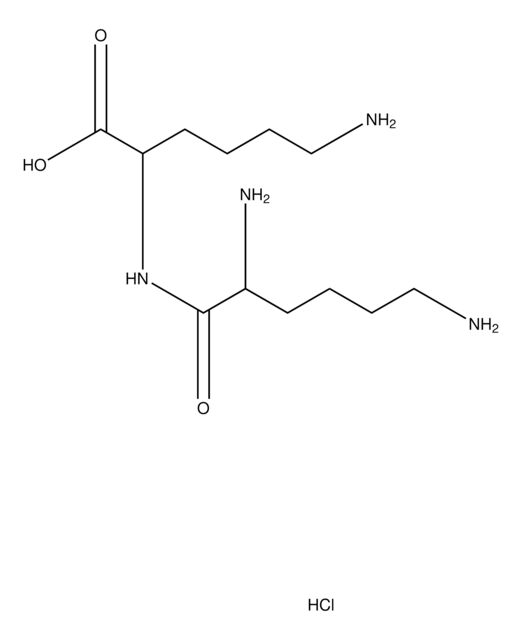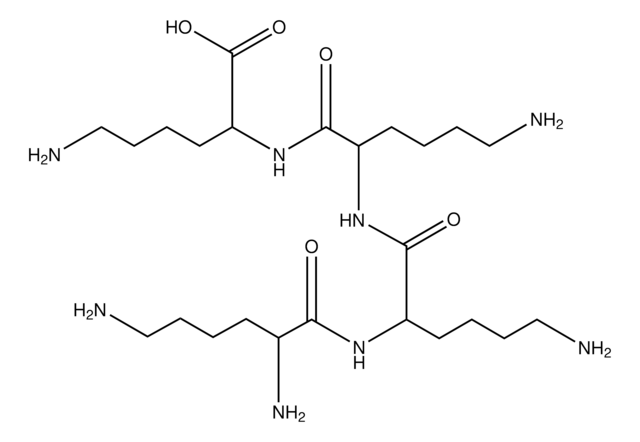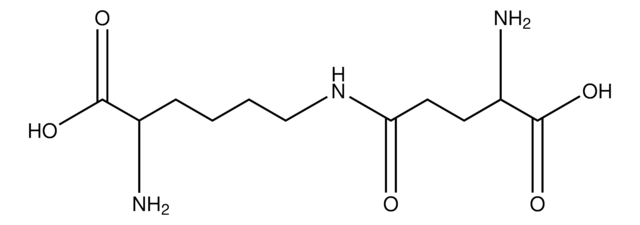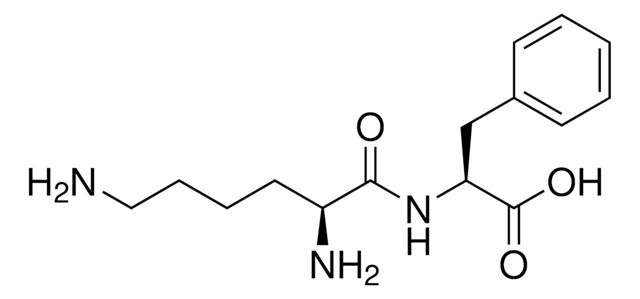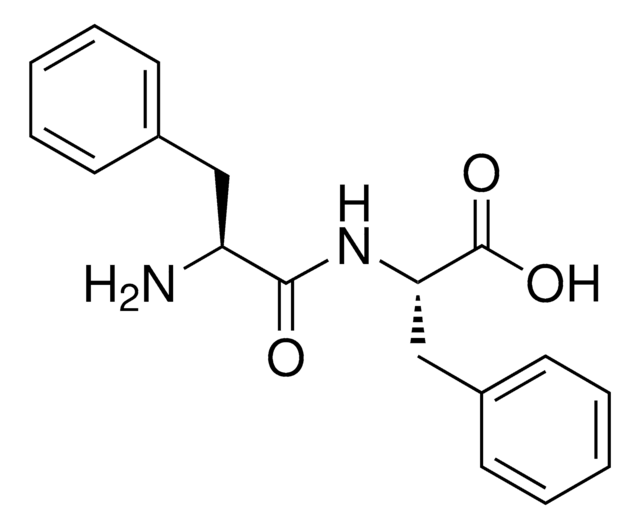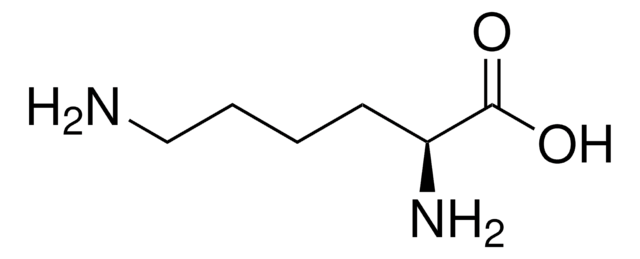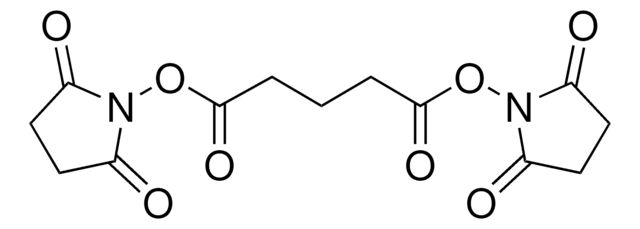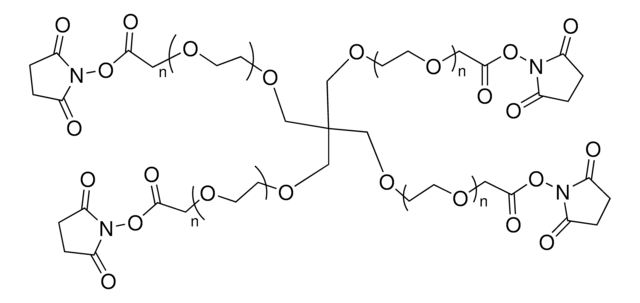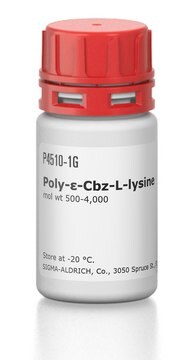L8901
Lys-Lys-Lys
≥97% (TLC)
Sinonimo/i:
Trilysine
Autenticatiper visualizzare i prezzi riservati alla tua organizzazione & contrattuali
About This Item
Formula empirica (notazione di Hill):
C18H38N6O4
Numero CAS:
Peso molecolare:
402.53
Numero MDL:
Codice UNSPSC:
12352209
ID PubChem:
NACRES:
NA.26
Prodotti consigliati
Nome del prodotto
Lys-Lys-Lys, ≥97% (TLC)
Livello qualitativo
Saggio
≥97% (TLC)
Stato
powder
Composizione
Peptide content, ~60%
Colore
white to off-white
Temperatura di conservazione
−20°C
Stringa SMILE
NCCCCC(N)C(=O)NC(CCCCN)C(=O)NC(CCCCN)C(O)=O
InChI
1S/C18H38N6O4/c19-10-4-1-7-13(22)16(25)23-14(8-2-5-11-20)17(26)24-15(18(27)28)9-3-6-12-21/h13-15H,1-12,19-22H2,(H,23,25)(H,24,26)(H,27,28)
WBSCNDJQPKSPII-UHFFFAOYSA-N
Amino Acid Sequence
Lys-Lys-Lys
Applicazioni
Short poly-L-lysines polypeptides such as trilysine (tri-L-lysine, lys3); tetralysine (tetra-L-lysine, lys4) and pentalysine (penta-L-lysine, lys5) are cationic moieties that may be used in the construction of gene delivery vectors and DNA nanoparticles.
Confezionamento
Bottomless glass bottle. Contents are inside inserted fused cone.
Codice della classe di stoccaggio
11 - Combustible Solids
Classe di pericolosità dell'acqua (WGK)
WGK 3
Punto d’infiammabilità (°F)
Not applicable
Punto d’infiammabilità (°C)
Not applicable
Dispositivi di protezione individuale
Eyeshields, Gloves, type N95 (US)
Scegli una delle versioni più recenti:
Possiedi già questo prodotto?
I documenti relativi ai prodotti acquistati recentemente sono disponibili nell’Archivio dei documenti.
I clienti hanno visto anche
Aboli A Rane et al.
PloS one, 6(6), e21571-e21571 (2011-07-07)
Several injectable materials have been shown to preserve or improve cardiac function as well as prevent or slow left ventricular (LV) remodeling post-myocardial infarction (MI). However, it is unclear as to whether it is the structural support or the bioactivity
Peter G Millili et al.
Microscopy research and technique, 73(9), 866-877 (2010-03-17)
Polycationic polymers have been used to condense therapeutic DNA into submicron particles, offering protection from shear-induced or enzymatic degradation. However, the spontaneous nature of this self-assembly process gives rise to the formation of multimolecular aggregates, resulting in significant polyplex heterogeneity.
Sandrine Perrier et al.
Journal of the American Chemical Society, 128(17), 5703-5710 (2006-04-28)
Formation of DNA-protein cross-links involving the initial formation of a guanine radical cation was investigated. For this purpose, riboflavin-mediated photosensitization of a TGT oligonucleotide in aerated aqueous solution in the presence of the KKK tripeptide was performed. We have shown
Yudan Ma et al.
Chemistry (Weinheim an der Bergstrasse, Germany), 15(47), 13135-13140 (2009-10-27)
Single-strand oligo-DNA-modified Au nanoparticles (AuNPs) undergo aggregation in the presence of poly(L-lysine) (PLL), which is attributed to the interactions between the oligo-DNA and PLL. These interactions between the oligo-DNA and PLL were identified to be electrostatic when the lysine residues
Fang Zong et al.
PloS one, 4(10), e7346-e7346 (2009-10-06)
Syndecan-1 forms complexes with growth factors and their cognate receptors in the cell membrane. We have previously reported a tubulin-mediated translocation of syndecan-1 to the nucleus. The transport route and functional significance of nuclear syndecan-1 is still incompletely understood. Here
Il team dei nostri ricercatori vanta grande esperienza in tutte le aree della ricerca quali Life Science, scienza dei materiali, sintesi chimica, cromatografia, discipline analitiche, ecc..
Contatta l'Assistenza Tecnica.
